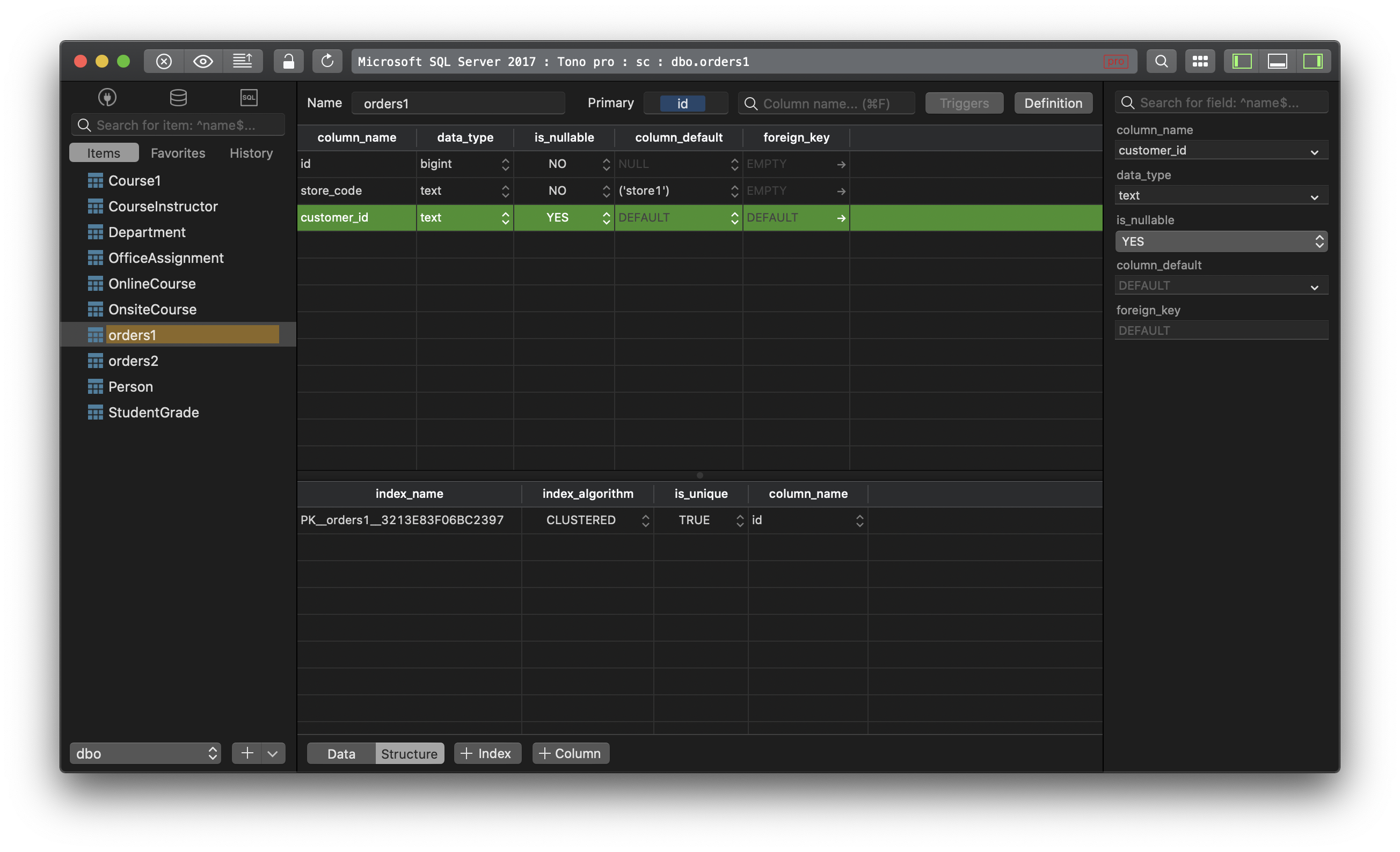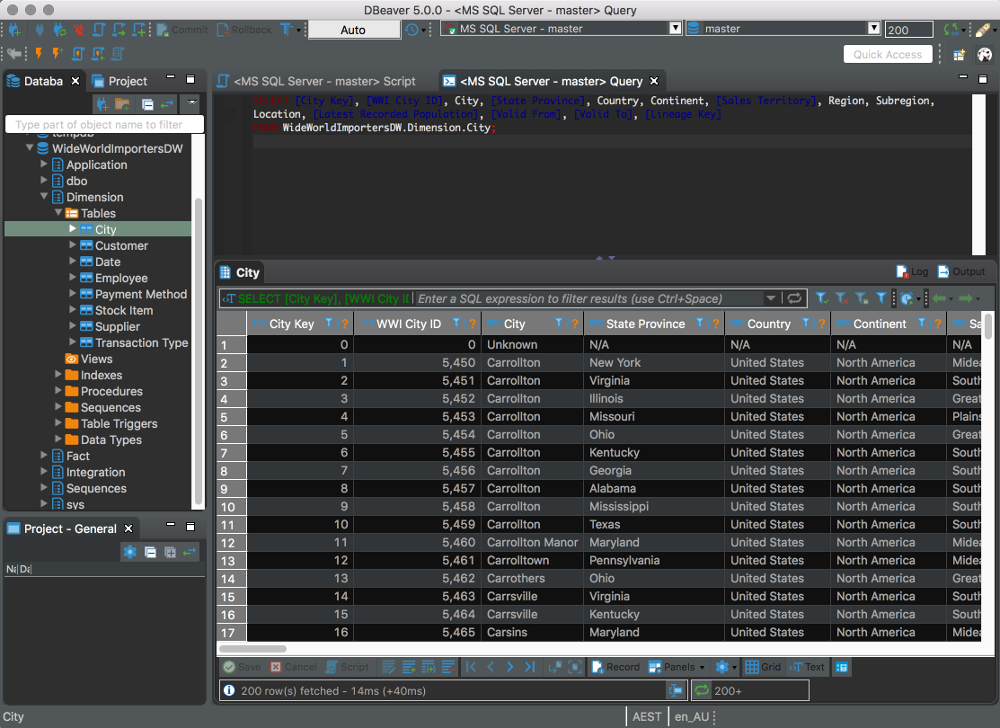Azure Data Studio is a cross-platform database tool for data professionals who use on-premises and cloud data platforms on Windows, macOS, and Linux.
SQL Server Management Studio for Mac. Archived Forums. You restore it and the restore process can be started from any client, which can access SQL Server.
- 7 of the Best Database Tools for Macs. Here's an overview of some of the best free and open source database software tools for Macs. I've also included a few personal database tools as well. SQLite's code is in the public domain, which makes it free for commercial or private use.
- MySQL Community Edition is a freely downloadable version of the world's most popular open source database that is supported by an active community of open source developers and enthusiasts.
Azure Data Studio offers a modern editor experience with IntelliSense, code snippets, source control integration, and an integrated terminal. It's engineered with the data platform user in mind, with the built-in charting of query result sets and customizable dashboards.
Use Azure Data Studio to query, design, and manage your databases and data warehouses wherever they are, on your local computer or in the cloud.
For more information about Azure Data Studio, visit What is Azure Data Studio?.
Download Azure Data Studio
Azure Data Studio 1.32.0 is the latest general availability (GA) version.
- Release number: 1.32.0
- Release date: August 18, 2021
| Platform | Download |
|---|---|
| Windows | User installer (recommended) System installer .zip file |
| macOS | .zip file |
| Linux | .deb file .rpm file .tar.gz file |
Note
Azure Data Studio currently does not support the ARM architecture.
If you have comments or suggestions or want to report a problem with downloading Azure Data Studio, submit an issue to our team on the Azure Data Studio feedback page.
Install Azure Data Studio
Windows installation
Important
Beginning with SQL Server Management Studio (SSMS) 18.7, Azure Data Studio is automatically installed alongside SSMS. Users of SQL Server Management Studio are now able to benefit from the innovations and features in Azure Data Studio. Azure Data Studio is a cross-platform and open-source desktop tool for your environments, whether in the cloud, on-premises, or hybrid.
To learn more about Azure Data Studio, check out What is Azure Data Studio or the FAQ.
This release of Azure Data Studio includes a standard Windows installer experience and a .zip file.
We recommend the user installer, which simplifies installations and updates and doesn't require Administrator privileges. (It doesn't require Administrator privileges because the location is under your user Local AppData (LOCALAPPDATA) folder.) The user installer also provides a smoother background update experience. For more information, see User setup for Windows.
User installer (recommended)
Download and run the Azure Data Studio user installer for Windows.
Start the Azure Data Studio app.
System installer
Download and run the Azure Data Studio system installer for Windows.
Start the Azure Data Studio app.
.zip file
Download the Azure Data Studio .zip file for Windows.
Go to the downloaded file and extract it.
Run
azuredatastudio-windowsazuredatastudio.exe.
Unattended installation for Windows
You can also install Azure Data Studio by using a command prompt script.
For Windows, install Azure Data Studio in the background without prompts by doing the following:
Open the command prompt window with elevated permissions.
Run the following command:
Example:
Note
The following example also works with the system installer file.
In the preceding code, you can also pass /SILENT instead of /VERYSILENT to see the setup user interface.
If you've run the commands successfully, you can see Azure Data Studio installed.
macOS installation
Download Azure Data Studio for macOS.
To expand the contents of the .zip file, double-click it.
To make Azure Data Studio available in Launchpad, drag the Azure Data Studio.app file to the Applications folder.
Linux installation
Install with a .deb file
Download Azure Data Studio for Linux by using the .deb file.
To extract the .deb file, open a new terminal window, and then run the following commands:
To start Azure Data Studio, run this command:
Note
You might have missing dependencies. To install them, run the following command:
Install with an .rpm file
Download Azure Data Studio for Linux by using the .rpm file.
To extract the file, open a new terminal window, and then run the following commands:
To start Azure Data Studio, run this command:
Note
You might have missing dependencies. To install them, run the following command:
Install with a .tar.gz file
Download Azure Data Studio for Linux by using the .tar.gz file.
To extract the file, open a new terminal window, and then run the following commands:
To start Azure Data Studio, run this command:
Note
You might have missing dependencies. To install them, run the following command:
Windows Subsystem for Linux
Install Azure Data Studio for Windows. Then, use the
azuredatastudiocommand in a Windows Subsystem for Linux (WSL) terminal just as you would in a standard command prompt. By default, the application is stored in your AppData folder.Start Azure Data Studio from the WSL command prompt. When you're using the default Windows installation, start the application by running the following command:
What's new with Azure Data Studio
For details about the latest release of Azure Data Studio, see Release notes for Azure Data Studio. Boom boom 128 kbps song dwonlod.
Download the GA release of Azure Data Studio
We recommend that you download the general availability (GA) release of Azure Data Studio.
Download the insiders build of Azure Data Studio
As an alternative, if you want to try out the beta features and send feedback, you can download the insiders build of Azure Data Studio.
Supported operating systems
Azure Data Studio runs on Windows, macOS, and Linux and is supported on the following platforms:
Windows operating systems
- Windows 10 (64-bit)
- Windows 8.1 (64-bit)
- Windows 8 (64-bit)
- Windows 7 (SP1)
- Windows Server 2022
- Windows Server 2019
- Windows Server 2016
- Windows Server 2012 R2 (64-bit)
- Windows Server 2012 (64-bit)
- Windows Server 2008 R2 (64-bit)
macOS operating systems
- macOS 10.15 Catalina
- macOS 10.14 Mojave
- macOS 10.13 High Sierra
- macOS 10.12 Sierra
- macOS 11.1 Big Sur
Linux operating systems
- Red Hat Enterprise Linux (RHEL) 8.3
- Red Hat Enterprise Linux 8.2
- Red Hat Enterprise Linux 8.1
- Red Hat Enterprise Linux 8.0
- Red Hat Enterprise Linux 7.4
- Red Hat Enterprise Linux 7.3
- SUSE Linux Enterprise Server v12 SP2
- Ubuntu 20.04
- Ubuntu 18.04
- Ubuntu 16.04
Note
Versions 7.3 and 7.4 of RHEL are no longer supported by Red Hat. RHEL 7.3 support ended November 30, 2018, and RHEL 7.4 ended August 31, 2019.
For more information, see the RHEL 7 Application Compatibility Guide or the RHEL 8 Application Compatibility Guide.

System requirements
| Requirement level | CPU cores | RAM memory |
|---|---|---|
| Recommended | 4 | 8 GB |
| Minimum | 2 | 4 GB |
Check for updates
To check for the latest updates, on the left pane, select Manage (gear icon), and then select Check for Updates.
To apply environment updates offline, install the latest version directly over your previously installed version. You don't need to uninstall earlier versions of Azure Data Studio. If an earlier version is present, the installer automatically updates to the latest version.
Free Sql Server Client For Mac Free
Move user settings
If you're updating SQL Operations Studio to Azure Data Studio and want to keep your settings, keyboard shortcuts, or code snippets, do the following:
Note
If you've already installed Azure Data Studio or you've never installed or customized SQL Operations Studio, you can ignore this section.
On the left pane, select Manage (gear icon) and then select Settings.
At the top, right-click the User Settings tab, and then select Reveal in Explorer.
Copy all files in this folder and save them in an easy-to-find location on your local drive, such as your Documents folder.
In your updated version of Azure Data Studio, follow steps 1 and 2 and then, for step 3, paste the contents you saved into the folder. You can also manually copy over the settings, key bindings, or snippets in their respective locations.
If you're overriding your current installation, before you do so, delete the old installation directory to avoid errors connecting to your Azure account for the resource explorer.
Uninstall Azure Data Studio from Windows
If you installed Azure Data Studio by using the Windows installer, uninstall it just as you would any Windows application.
If you installed Azure Data Studio with a .zip file or other archive, delete that file.
Uninstall Azure Data Studio from macOS
You can uninstall apps from the internet or disc on Mac by doing the following:
Select the Finder icon in the Dock, and then select Applications in the Finder sidebar.
Do one of the following:
If an app is in a folder, open the app's folder to check for an uninstaller. Double-click Uninstall [App] or [App] Uninstaller, and then follow the onscreen instructions.
If an app isn't in a folder or doesn't have an uninstaller, drag the app from the Applications folder to the Trash (at the end of the Dock).
To uninstall apps you've downloaded from the App Store, use Launchpad.
Uninstall Azure Data Studio from Linux
In Debian
You can uninstall Azure Data Studio under Debian or Ubuntu Linux.

To list installed software type, run the following commands:
To delete the software, run the following commands:
In RedHat
Use the rpm or yum command to delete Azure Data Studio.
To list the installed software type, run the following commands:
To get information about the azuredatastudio package, run the following commands:
To delete a package called azuredatastudio, run the following commands:
Next steps
To learn more about Azure Data Studio, see the following resources:
Get help for SQL tools
Contribute to SQL documentation
Did you know that you can edit SQL content yourself? If you do so, not only do you help improve our documentation, but you also get credited as a contributor to the page.
For more information, see How to contribute to SQL Server documentation
Microsoft Privacy Statement and Enable or disable usage data collection for Azure Data Studio.
MySQL Community Edition is a freely downloadable version of the world's most popular open source database that is supported by an active community of open source developers and enthusiasts.
MySQL Cluster Community Edition is available as a separate download. The reason for this change is so that MySQL Cluster can provide more frequent updates and support using the latest sources of MySQL Cluster Carrier Grade Edition.
MySQL 8.0 is the most current GA release. Download MySQL 8.0 »
Learn What's New in MySQL 8.0 and view the Performance Benchmarks.
Online Documentation:
| Looking for previous GA versions? |
Free Sql Server Client For Mac 2019
Please report any bugs or inconsistencies you observe to our Bugs Database.
Thank you for your support!